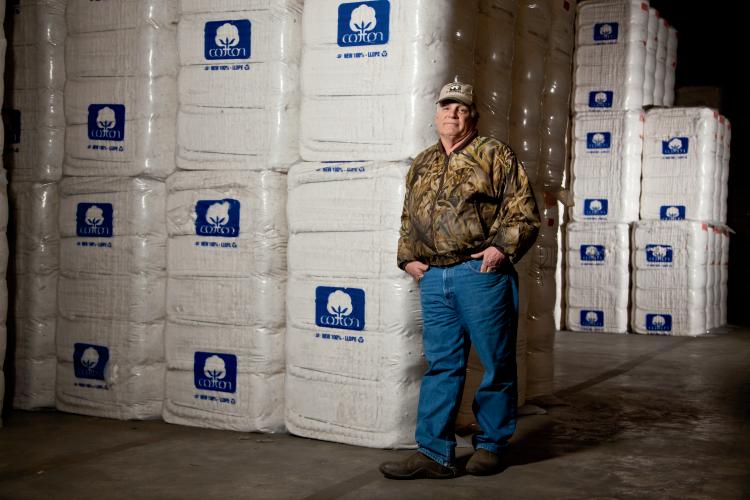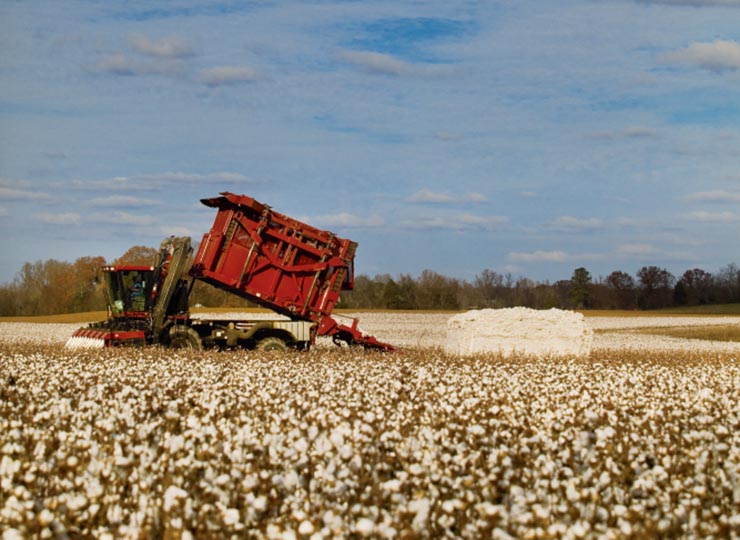Home > South Carolina > South Carolina Crops & Livestock > Cotton Remains Staple Crop for South Carolina
Cotton Remains Staple Crop for South Carolina

What do the binding of a book, a pair of jeans, a coffee filter and a two-man tent have in common? Or should we say, what do they have in cotton?
It’s that soft, fluffy fiber that shows up in consumer staples from textile products to food. And for decades, it’s a crop that has been a staple of South Carolina’s agriculture economy.
“Historically, we were one of the first states to raise cotton,” says Tre Coleman, executive vice president for the South Carolina Cotton Board. “Since revolutionary times to current day, it’s been an important cash crop. Although the acreage in the state does fluctuate with the price for cotton, currently we have almost 300,000 acres in cotton production in the state.”
Coleman says part of the reason the state has a long tradition of growing cotton is because it is a strong environmental fit with the climate.
“Cotton can tolerate the heat and still produce consistent yields,” he explains. There’s also the practical fit, he says, with cotton being a strong complement in rotation with the peanut crop.
Harry Ott, a Calhoun County farmer, agrees. He credits rotation practices with boosting cotton production. “We always see improved yields with cotton after we plant peanuts, because the peanuts decrease the nematode population, which creates a favorable environment for the cotton crop the next year.”
Ott, whose 2,200-acre operation is a mix of cotton, peanuts and corn, says the climate also makes South Carolina an ideal place to grow cotton. “In South Carolina, we have a long growing season. Very seldom do we get an early frost, and if the temperatures stay in the 85- to 95-degree range and we can keep some water on the crop, it can make for a really strong season for cotton.”
From Boll to Bale
On the Ott farm, like many cotton farms across the state, the crop is planted in late April. About two months later, the flower buds, or squares, appear on the cotton plants. After three weeks, the buds open and then within three days those blooms wither, leaving just the green pods, or cotton bolls. It is the boll that contains the cotton fibers, which expand and finally split the boll, exposing the cotton.
That’s when farmers bring out the cotton balers and start harvesting.
“We use conventional balers to do the work starting in October,” says Ott. “We finish that process by Thanksgiving, and then we gin the cotton.”
The cotton “gin,” short for “engine,” was invented by Eli Whitney in 1793. It separates the seed from the fiber, a job that prior to Whitney’s discovery was done by hand. The separated fiber, now called lint, is pressed into 500-pound bales and sold.
While most farmers do not gin their own cotton, Ott does. He is part owner of a cotton gin, which he says “can run from harvest through January, depending on the capacity of the gin and the number of farmers who bring us their cotton.”
Bales aren’t the only end product, however. The seed that is separated from the fiber is also sold and processed into cottonseed oil, meal and hulls. Those products are used for everything from livestock feed to potato chips to salad dressings.

Yielding Results
What can you make from a 4-foot-tall, 500-pound bale of cotton? Plenty – 3,400 pairs of socks, 750 shirts or 325 pairs of jeans, for example. With more than 500,000 bales of cotton produced in South Carolina in 2012, that’s a lot of socks – and a big economic impact. The state’s cotton farmers also produced more than 150,000 tons of cottonseed. Total cash receipts for the cotton crop in 2011 totaled almost $217 million.
Both Coleman and Ott say improved seed genetics have been a boon to this bottom line, allowing cotton farmers to improve their yields. “Where we used to be happy if we could produce a bale per acre, genetic improvements have boosted that to two to three bales an acre,” says Ott.
But there are challenges, too. While the boll weevil that decimated the cotton crop in the 1920s and 1930s is no longer the threat it used to be, another pest has cropped up to give cotton farmers fits. “One of the biggest challenges for those of us who are ‘blessed’ to have resistant pigweed in our fields is getting rid of it,” says Ott.
There are economic challenges to growing cotton as well. Fluctuating prices for the crop are part of the challenge, says Coleman, as are trade issues. Ott agrees, explaining that a decline in the textile industry in the state has had an effect. “I’m hopeful that here in South Carolina, we will encourage the textile industries to remain here and use locally grown cotton.”



